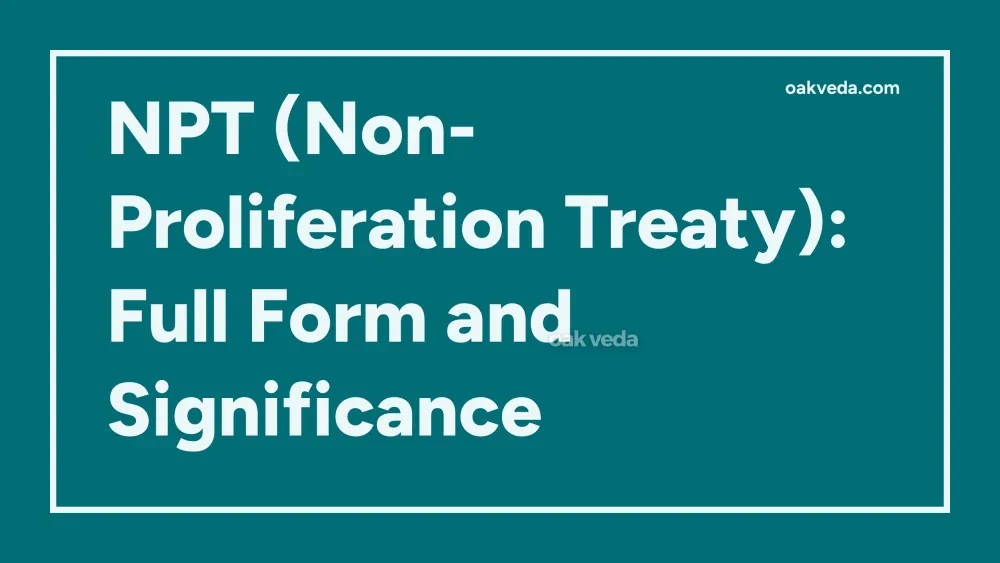
What is the Full Form of NPT?
The full form of NPT is the Treaty on the Non-Proliferation of Nuclear Weapons, commonly known as the Non-Proliferation Treaty. This international agreement plays a crucial role in global efforts to prevent the spread of nuclear weapons and promote the peaceful use of nuclear energy.
What is the Treaty on the Non-Proliferation of Nuclear Weapons?
The Treaty on the Non-Proliferation of Nuclear Weapons, or NPT, is a landmark multilateral agreement aimed at curbing the spread of nuclear weapons worldwide. It serves as the cornerstone of the global nuclear non-proliferation regime and promotes international cooperation in the peaceful applications of nuclear technology.
Origin and Development of the Non-Proliferation Treaty
The NPT was opened for signature on July 1, 1968, and entered into force on March 5, 1970. The treaty was initially designed to be temporary, with a 25-year duration. However, in 1995, it was extended indefinitely, reflecting its critical importance in maintaining global security.
Key milestones in the NPT's development include:
- 1968: Treaty opened for signature
- 1970: Treaty entered into force
- 1995: Indefinite extension of the treaty
- Regular review conferences held every five years
How does the Non-Proliferation Treaty work?
The NPT operates on three fundamental pillars:
- Non-proliferation: Non-nuclear weapon states agree not to acquire or develop nuclear weapons.
- Disarmament: Nuclear weapon states commit to pursuing negotiations towards complete disarmament.
- Peaceful use of nuclear energy: All states have the right to develop nuclear energy for peaceful purposes.
The International Atomic Energy Agency (IAEA) plays a crucial role in implementing the NPT by conducting inspections and verifying compliance with the treaty's provisions.
Functions of the Non-Proliferation Treaty
The NPT serves several vital functions in maintaining global nuclear security:
- Preventing the spread of nuclear weapons
- Promoting disarmament efforts among nuclear weapon states
- Facilitating the peaceful use of nuclear technology
- Establishing a framework for international cooperation in nuclear matters
- Enhancing global security and stability
Applications of the Non-Proliferation Treaty
The NPT has wide-ranging applications in international relations and nuclear governance:
- Diplomatic tool: Serves as a basis for negotiations on nuclear-related issues
- Legal framework: Provides a foundation for national and international laws on nuclear matters
- Verification mechanism: Enables the IAEA to monitor nuclear activities worldwide
- Technology transfer: Facilitates the sharing of peaceful nuclear technology
- Conflict prevention: Helps reduce tensions related to nuclear proliferation
Features of the Non-Proliferation Treaty
Key features of the NPT include:
- Near-universal membership: With 191 state parties as of 2023, it is one of the most widely adopted international treaties
- Legally binding: Imposes obligations on both nuclear and non-nuclear weapon states
- Regular review process: Allows for periodic assessment and adaptation of the treaty
- Safeguards system: Establishes a comprehensive verification regime through the IAEA
- Withdrawal clause: Permits states to withdraw under extraordinary circumstances related to national security
Benefits of the Non-Proliferation Treaty
The NPT has yielded significant benefits for global security and nuclear governance:
- Limiting the spread of nuclear weapons
- Promoting international cooperation in peaceful nuclear activities
- Enhancing transparency in nuclear programs
- Strengthening global norms against nuclear proliferation
- Providing a framework for nuclear disarmament efforts
Limitations or Challenges of the Non-Proliferation Treaty
Despite its successes, the NPT faces several challenges:
- Slow progress on disarmament: Nuclear weapon states have been criticized for not making sufficient progress towards disarmament.
- Non-universality: Some key states remain outside the treaty, including India, Pakistan, and Israel.
- Compliance issues: Concerns about non-compliance by certain states, such as North Korea's withdrawal and Iran's past activities.
- Technological advancements: Emerging technologies pose new challenges to the non-proliferation regime.
- Balancing non-proliferation and peaceful use: Ensuring access to peaceful nuclear technology while preventing proliferation remains a challenge.
Future Developments in Non-Proliferation Treaty Implementation
As the global security landscape evolves, the NPT must adapt to new challenges:
- Strengthening verification measures: Developing more robust monitoring and inspection capabilities
- Addressing non-NPT states: Finding ways to engage countries outside the treaty
- Enhancing disarmament efforts: Encouraging concrete steps towards nuclear disarmament
- Tackling new technologies: Addressing challenges posed by emerging nuclear technologies
- Promoting regional cooperation: Encouraging nuclear-weapon-free zones and regional initiatives
FAQs on NPT Full Form
-
What does NPT stand for in nuclear context? NPT stands for the Treaty on the Non-Proliferation of Nuclear Weapons, commonly known as the Non-Proliferation Treaty.
-
When was the NPT signed and entered into force? The NPT was opened for signature on July 1, 1968, and entered into force on March 5, 1970.
-
How many countries are party to the NPT? As of 2023, 191 states are parties to the NPT, making it one of the most widely adopted international treaties.
-
What are the three pillars of the NPT? The three pillars are non-proliferation, disarmament, and peaceful use of nuclear energy.
-
Can a country withdraw from the NPT? Yes, the treaty allows for withdrawal under extraordinary circumstances related to a country's supreme national interests, with a three-month notice period.
In conclusion, the Non-Proliferation Treaty (NPT) remains a cornerstone of global efforts to prevent the spread of nuclear weapons while promoting the peaceful use of nuclear energy. Despite facing challenges, its continued relevance and near-universal adoption underscore its importance in maintaining international security and fostering cooperation in nuclear matters.
You may be interested in:
- ACD (Automatic Call Distributor): Enhancing Call Management
- NDRF (National Disaster Response Force)
- AWBI (Animal Welfare Board of India): Full Form
- CGL (Combined Graduate Level) Full Form
- ICWAI (Full Form): Institute of Cost and Works Accountants of India
- MA (Master of Arts): Full Form and Comprehensive Guide

